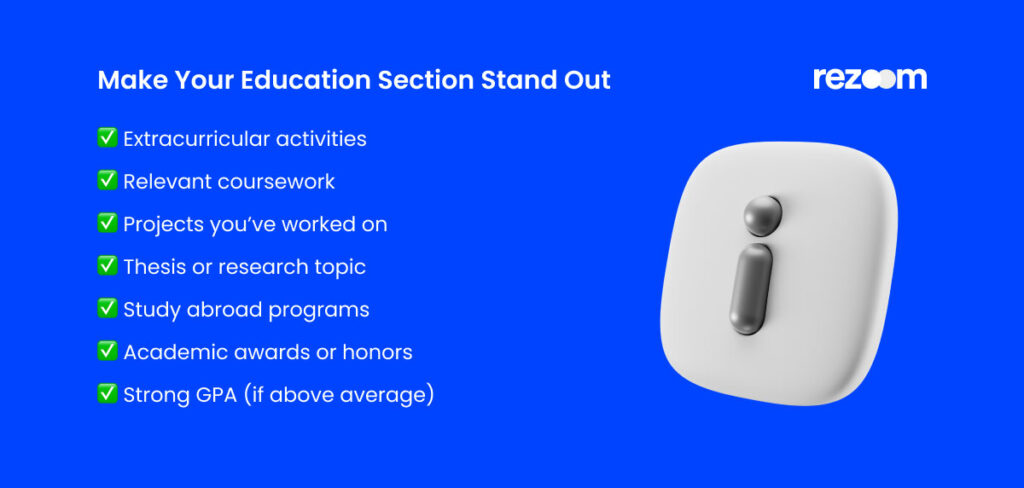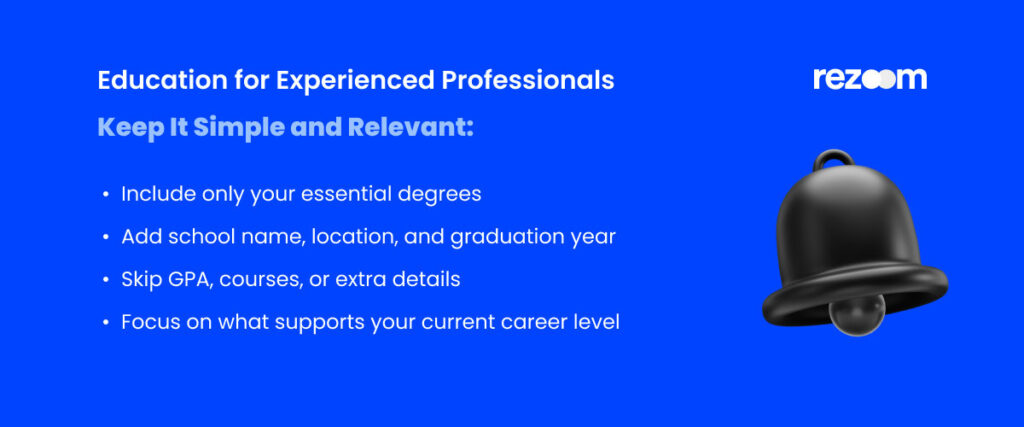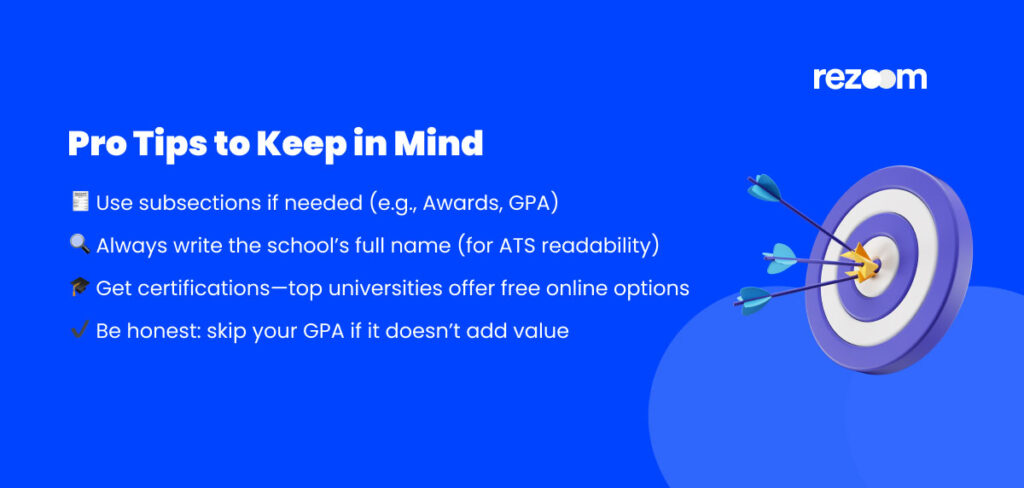How to List Education on Your Resume (2025)

Your education forms the foundation of your professional journey. Knowing how to List Education on Your Resume effectively can influence your chances of landing your desired role. Whether you are a recent graduate who must highlight academic accomplishments or a seasoned professional looking to update your qualifications, this guide covers the essential steps to present your education convincingly.
Employers examine your education section to gauge whether you have the relevant training and discipline required for the position. A carefully organized education section not only validates your academic background but also strengthens your entire resume. By following the recommendations below, you will learn to List Education on Your Resume in a way that emphasizes your strengths and aligns with your career objectives.
Recommended Podcast:
1. Why You Should List Education on Your Resume
Education serves as a concise representation of your academic history. It assures employers that you possess the theoretical grounding necessary for the job. Moreover, well-presented credentials show you have the resilience to complete rigorous programs. This is especially beneficial for new graduates who may have limited professional background.
A carefully detailed education section reinforces your expertise and introduces relevant coursework, honors, or awards. Ultimately, if you List Education on Your Resume in a clear, logical fashion, it will strengthen your personal narrative and support your qualifications.
Check out LinkedIn to explore potential ways your peers structure their education in professional profiles.
2. Where to Position and List Education on Your Resume
The placement of your education section depends on your level of experience and how pertinent your academic background is.
For Students or Recent Graduates:
- Prominently at the Top:
Place your education section just below your contact info and summary. Doing so immediately highlights your academic achievements.
For Experienced Professionals:
- Below Work History:
If you have ample work experience, let your professional track record take center stage while still ensuring the education section is easy to find.
In Academic or Research-Oriented Fields:
- Highly Visible:
Even if you possess significant work experience, your academic history might need prominent placement if it is critical to the job’s requirements.
By following a reverse-chronological order, you ensure the most recent or highest degree stands out, reinforcing the value you bring to potential employers.
Platforms like Indeed can offer additional advice on where to position your education based on specific roles or industries.
3. Key Components for Listing Education on Your Resume

A well-crafted education section typically includes the following components. When you decide to List Education on Your Resume, be sure to include:
- Degree or Certification:
Specify the full title of your degree (e.g., Bachelor of Science in Biology). Students who are still enrolled should add an “Expected” graduation date. - Institution Name:
Provide the official name of the educational institution. - Location:
Include the city, state, or country where you studied. - Dates of Attendance or Graduation:
Indicate the period you were there, using either a date range or a graduation date (e.g., May 2022). - Academic Achievements:
Mention your GPA (if strong), honors, or special projects relevant to the role. - Relevant Coursework:
This detail benefits candidates with limited job experience but who have completed noteworthy courses that align with the job’s demands.
This approach presents necessary facts succinctly and effectively.4. Step-by-Step Guide: How to List Education on Your Resume
Below is a straightforward process to assemble a strong education section. Each step ensures your information remains organized and easy to read.
4.1 Step 1: Begin with Your Most Advanced Academic Credential
Always start with your highest degree or the most relevant academic qualification. If you hold a master’s or doctorate, list it first. Alternatively, students may note an expected graduation date
Selecting varied sentence starters, such as “Always,” “If,” and “Alternatively,” keeps the text engaging.
4.2 Step 2: Specify Institution, Location, and Dates
After identifying your degree, clearly name the institution and its location. Then provide the date of graduation or attendance range.
Vary sentence openers by using terms like “After,” “Then,” and “Next” to prevent repetitive structures.
4.3 Step 3: Highlight GPA, Honors, and Thesis Details
If you have significant academic achievements, add them here. For instance, you can include an impressive GPA, any honors, or even the title of your thesis.
By introducing transitions such as “If,” “For instance,” and “Furthermore,” your paragraph remains smooth and varied.
4.4 Step 4: Tailor Your Education Section to Career Stage
Adapting the education section to align with your professional standing ensures it complements the rest of your resume.
Students and Recent Graduates:
- Place the education section at the top.
- Provide added detail, including extracurriculars, relevant courses, and academic honors.

Mid-Level Professionals:
- Position this section below the work history.
- Focus on degrees or certifications that matter most to the role.

Academics and Researchers:
- Incorporate a more in-depth format (sometimes a CV), including publications, fellowships, or awards.
- Emphasize details such as dissertation topics or peer-reviewed research.
Use transitional words like “Meanwhile,” “Additionally,” or “Similarly” to maintain an engaging flow and avoid repeating sentence starters.
5. How to List Education on Your Resume Without a College Degree
Not everyone earns a traditional degree, yet relevant training can still prove one’s capabilities. If one doesn’t have a college diploma, highlight alternative credentials that exhibit one’s career readiness.
Possible Options:
- High School Diploma:
If it is your top academic achievement, list it. - Vocational or Trade School Training:
Show specialized programs that qualify you for certain roles. - Online Courses & Bootcamps:
Emphasize well-known providers like Coursera or Udacity, particularly if these courses are applicable to the job. - Professional Certificates:
Include industry-recognized credentials, such as Project Management Professional (PMP) or a coding certification.
This example displays how you can List Education on Your Resume without a formal college degree while still showing valuable skill development.
6. Listing Ongoing or Incomplete Education on Your Resume
Clarifying the status of unfinished education can help prospective employers understand where you stand academically.
Best Practices:
- Indicate “Expected” Dates:
For instance, use “Expected: May 2024” to clarify your timeline. - Include Relevant Courses:
If certain classes align with the role, list them to show current competence. - Mention Significant Milestones:
Highlight noteworthy research or projects completed so far.
Strive to alternate first words in consecutive sentences by using “Clarifying,” “If,” or “Highlight” to maintain variety.
7. Incorporating Certifications, Courses & Workshops
Modern careers often require continuous learning. Certifications and ongoing training can bolster your credibility when you List Education on Your Resume.
Suggested Inclusions:
- Course or Certification Name:
Provide the official title. - Institution or Platform:
Clarify where you studied, such as Coursera or a local training center. - Completion Date:
Include the month and year. - Relevant Accomplishments:
If the program involved notable projects or advanced topics, note them briefly.
Use transitional words like “Moreover,” “Additionally,” and “However” to manage sentence variety.
8. Real-World Examples: How to List Education on Your Resume
Examples can guide you in structuring your educational background. Below are different scenarios to illustrate how this may look.
Recent Graduate Example:
Browsing Glassdoor can give you more examples of how professionals in various industries structure their education.
Experienced Professional Example:
Candidate Without a College Degree Example:
Academic/Research Professional Example:
Explanation:
A robust academic layout with dissertations or publications is essential for scholarly roles.
9. Common Pitfalls When Presenting Education on Your Resume
Avoid these mistakes to ensure your education section remains clear, concise, and compelling.
Overloading with Irrelevant Details:
- Pitfall: Listing information from elementary school onward.
- Tip: Include only post-secondary education and credentials that align with the role.
Inconsistent Formatting:
- Pitfall: Using different date or style formats for each entry.
- Tip: Standardize your approach—e.g., always use “Graduated: Month Year.”
Excessive Detail:
- Pitfall: Adding unnecessary minutiae like lengthy course lists when you have ample job experience.
- Tip: Present only the highlights that support your candidacy.
Omitting Key Information:
- Pitfall: Leaving out the institution’s location or failing to mention graduation dates.
- Tip: Verify each entry for completeness and consistency.
Lack of Customization:
- Pitfall: Using the same education section for every job application.
- Tip: Emphasize the elements that best fit each specific position.
In each paragraph, start some sentences with transitions like “Additionally,” “Consequently,” or “Finally” to avoid identical openers.
10. Frequently Asked Questions About How to List Education on Your Resume
Consider these common questions to resolve any lingering doubts about organizing your education section.
Yes, if your GPA is 3.5 or above and adds to your candidacy. Otherwise, omitting it may simplify your resume.
Focus on post-secondary qualifications. High school details may be irrelevant if you already have college-level achievements.
Clearly state an expected graduation date, such as “Expected: May 2024.”
No, in most cases it can be excluded unless you are a recent high school graduate or it is directly pertinent.
Absolutely. Emphasize recognized platforms or notable professional certifications. Mention relevant projects or advanced skills where possible.
Seasoned applicants can keep it concise while newer candidates should add more detail, such as coursework or honors.
11. Key Takeaways to List Education on Your Resume
Keep the following pointers in mind to create a compelling education section:

- Maintain Uniformity:
Every entry should include degree, institution, location, and dates in a consistent format. - Highlight Achievements:
Mention honors, awards, or relevant coursework that demonstrates your abilities. - Be Selective:
Only list items that strengthen your application. Omit unrelated details if you have extensive job experience. - Stay Flexible:
Tailor your education section to match the expectations of your field or career phase. - Support Overall Resume:
When you carefully list education on your resume, it will seamlessly complement your skills, work history, and achievements.
By following these guidelines, your education section will make a strong statement about your qualifications and career readiness.
12. Final Thoughts: Rezoom Helps You Create the Ideal Resume
Learning how to List Education on Your Resume effectively can transform your academic accomplishments into a genuine competitive advantage. Presenting your degrees, certifications, or ongoing studies in the best possible light underscores the value you bring to future employers.
At Rezoom.io, we provide tools and guidance so you can craft a resume that fully represents your capabilities. Whether you’re just starting out or climbing the professional ladder, Rezoom is here to help you refine your education section along with every other aspect of your resume. Update your credentials now and let Rezoom support you in achieving your career aspirations.
Rate this article
6 people rated this article



Comments